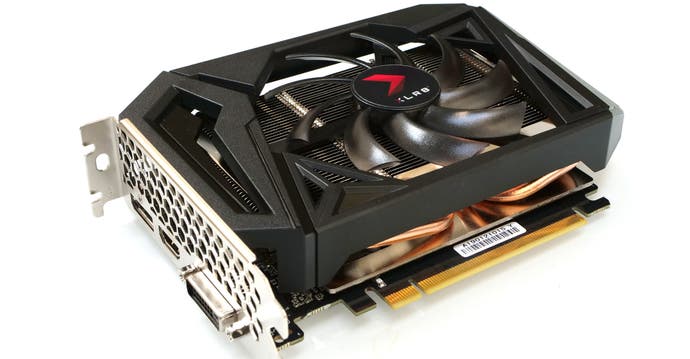GTX 1660 Ti vs RTX 2060: benchmark performance and feature comparison
Nvidia's two entry-level Turing cards tested.
The GTX 1660 Ti is something of an oddball: the first Turing card without RTX features or indeed the RTX name, a £260/$280 successor to the GTX 1060 that delivers performance on par with the GTX 1070. That makes it hard to anticipate how it compares to the other mainstream Nvidia GPU, the RTX 2060, which was released at the beginning of 2019 and has an RRP of £320/$350. This article is intended to put an end to the guessing games, as we show you exactly how these two cards compare in terms of performance, what extra features you get from the RTX card and how they sit in terms of current pricing and availability.
For our performance comparison, we'll include live game benchmarks from a range of the latest titles and legacy favourites, from Assassin's Creed Odyssey to the Witcher 3. While these cards are designed to tackle 1080p and stretch to 1440p gaming, we'll also see how they handle 4K at a pinch. (However, if you are considering either card for a 4K setup, we'd instead recommend at least looking at the RTX 2070 or GTX 1080 unless you're content to turn down your settings far below the high or ultra presets we tested at and pick up a high-end processor to boot.) Finally, we've also included a generational benchmark, so you can get a general idea of gaming performance if you're upgrading from an older GeForce GTX card.
If you're interested in the benchmark or pricing for these two cards, then feel free to click on the links below to get straight to the relevant section. Otherwise, scroll on and take it all in!
- GTX 1660 Ti vs RTX 2060: Features
- GTX 1660 Ti vs RTX 2060: Benchmarks
- GTX 1660 Ti vs RTX 2060: Price and availability

| GPU cores | VRAM | Memory Bus | Bandwidth | Boost Clock | TDP | |
|---|---|---|---|---|---|---|
| GTX 1660 Ti | 1536 | 6GB GDDR6 | 192-bit | 288GB/s | 1770MHz | 120W |
| RTX 2060 | 1920 | 6GB GDDR6 | 192-bit | 336GB/s | 1680MHz | 160W |
GTX 1660 Ti vs RTX 2060: Feature comparison
For two members of obstensibly the same Turing generation, the GTX 1660 Ti and RTX 2060 are suprisingly dissimilar. The RTX card includes specialised RT and Tensor cores, allowing you to use Nvidia's implementation of real-time ray tracing (RTX) and deep learning super sampling (DLSS). While not many games support this technology yet, with Metro Exodus and Battlefield 5 being the most notable examples, they could be deeply transformative features.
Real time ray tracing realistically renders light and shadow in a scene, incurring a heavy performance penalty but providing a unique look. In Metro, switching between RTX off and on can make a huge difference to how a room looks, with the baked and faked lights of traditional rendering techniques paling in comparison to authentically lit scenes, especially in dark areas. Meanwhile, in Battlefield 5, RTX allows you to see around obstacles by looking at reflections, providing new tactical possibilities.
You may well still prefer higher frame-rates to these atmospheric tweaks, but it's nice to have the option - especially when DLSS has the potential to claw some of the lost performance. DLSS essentially lowers the internal rendering resolution of the game, then makes up for the loss in image quality by intelligently upscaling based on the algorithm's knowledge of how the game ought to look at high resolutions. The success of DLSS can vary from game to game and improve over time, but when it goes well, it provides an instant improvement in performance.
Of course, DLSS and RTX are only supported in a handful of games at this point, so their utility is limited at best. And from that point of view, there's little to separate the 1660 Ti and 2060.
Both GPUs lack the USB-C VirtualLink port of the higher-tier RTX cards, but both support new shader techniques like Variable Rate Shading which can see performance advantages in games that support it. So far that list of games only includes Wolfenstein 2: The New Colossus, where you can get up to a 15 per cent frame-rate boost when the tech is enabled.
Both cards are also able to stream or record game footage with less CPU utilisation than on last generation cards, thanks to a new iteration of the NVENC encoder. Finally, both support both G-Sync and FreeSync variable refresh rate monitors, so you'll be able to consider a wide range of the best gaming monitors for your setup.
One last point of contention is the size of these two cards. As you can see from the picture of our test unit above, the GTX 1660 Ti is available in some very compact form factors indeed, which are well-suited to cramped cases where space is at a premium. The RTX 2060 can also be had in these configurations, but the GTX card's marginally lower power requirements mean that the newcomer gets a narrow advantage here.
GTX 1660 Ti vs RTX 2060: Benchmarks
We tested the GTX 1660 Ti and RTX 2060 in a high-end system, built around a Core i7-8700K processor with all cores pinned to 4.7GHz and kept cool with a Corsair all-in-one liquid cooler. If you're looking to make use of a high refresh rate monitor, we recommend sticking with at least a recent Core i5 or Ryzen 5 processor, with better results coming from a Ryzen 7 or Core i7 CPU. That means these results represent a best-case scenario in some respects, and especially at 1080p weaker CPUs will impact performance in some games. It's also worth noting that our PNY XLR8 GTX 1660 Ti comes with a nominal 45MHz overclock, while the RTX 2060 is a Nvidia Founders Edition tested at stock clocks. With both cards being entry-level options, this should be a fair fight.
If you're new to Digital Foundry, you might not have seen our unique system for showing benchmark results before. The general idea is that instead of using static bar charts or burned-in video data, we're combining the two into a dynamic system. Press play on the test scene for each game, and you'll see live frame-time and frame-rate data that gives you a better idea of performance than a traditional average frame-rate figure. You can choose which cards at which resolutions you want to see with the controls to the right of the video, with up to four data sources being shown at once.
If you're in a rush though, you can also find average frame-rate figures in a barchart below. Here, you can also mouse over the chart to see how each card did at the best or worst moments of the benchmark, which can tell a different stories than the averages alone. You can also click on the resolution tabs on the right to filter between 1080p, 1440p and 4K results. It's worth mentioning too that you can click on the chart to change between frame-rate values and percentages, which can make comparisons between different cards and resolutions a bit easier. Now, let's get started.
Assassin's Creed Odyssey
Assassin's Creed Odyssey is a challenging test even for high-end cards, so we're not expecting brilliant performance here - even at 1080p. The RTX 2060 comes the closer of the two cards, but both fall short of 60fps at the punishing ultra high preset we've selected. The performance gap is only 10 per cent between the two cards at 1080p, but this rises to 19 per cent at 1440p and 23 per cent at 4K.
AC Odyssey: Ultra High, TAA
Assassin's Creed Unity
How do things compare in an older AC title, 2014's Unity? The RTX 2060 uses its horsepower advantage to get even further ahead here, with a cool 16 per cent lead at 1080p. The gap rises by another two per cent as we step to the next rung in the resolution ladder, with only the RTX 2060 capable of averaging over 60fps at 1440p. However, both cards are good enough at 1080p.
Assassin's Creed Unity: Ultra High, FXAA
Battlefield 1
Battlefield 1 is a suprisingly easy title to run on mid-range hardware, and that's shown ably here by our run through French no man's land in a British tank. The RTX 2060 outpaces the GTX 1660 Ti by 15 per cent at 1080p, with the former basically able to max out a 144Hz monitor at this resolution. We're still north of 80fps for both cards at 1440p, and even 4K is playable with frame-rate averages of 47fps for the GTX 1660 Ti and 56fps for the RTX 2060. However, the GTX card is nowhere near as consistent as its RTX opposition, with some big frame-time spikes evident throughout the test and a disappointing 35fps worst one per cent measurement.
Battlefield 1: Ultra, TAA
Crysis 3
Six years on, Crysis 3 remains a challenge at higher resolutions. The 1080p experience is ideal for both cards, north of 100fps, and things are still playable at 1440p with averages of 63 and 76fps. It's only at 4K that we get into problems, with the GTX card averaging south of 30fps. On average, we're looking at about 20 per cent more performance for the RTX 2060.
Crysis 3: Very High, SMAA T2X
Far Cry 5
Far Cry 5 is a fun game, and its benchmark is one of the most relaxing we have in our pool at the moment. That isn't really relevant to the performance, but I'm trying to entice you to try it on your own system if you haven't already. Moving onto the results, the RTX 2060 has a 14 per cent advantage at 1080p, increasing to 17 per cent at 1440p and 4K. Both 1080p and 1440p play fine here, with 4K again being the pain point.
Far Cry 5: Ultra, TAA
Ghost Recon Wildlands
Ghost Recon Wildlands is the most challenging test we have in our current suite, so it's impressive that the RTX 2060 manages to sit just a touch below 60fps at 1080p, 13 per cent beyond the GTX 1660 Ti. The GTX card seems to struggle here, with worst one per cent times that vary substantially from the average, while the RTX 2060 remains relatively consistent.
Ghost Recon Wildlands: Ultra, TAA
Rise of the Tomb Raider
In the first of two Tomb Raider titles, both cards hit more than 100fps at 1080p and more than 60fps at 1440p. However, with the real game annoyingly harder to run than the integrated benchmark, you may have to turn down a few settings to get this level of performance in the game proper. The performance gap between the two cards is a little less than 20 per cent.
Rise of the Tomb Raider: Very High, SMAA
Shadow of the Tomb Raider
Shadow of the Tomb Raider is a more modern title; it's even set to support RTX ray tracing at some indeterminate point in the future. That means that it's no surprise that we see less performance here, in exchange for greater graphical fidelity. The differential between the two cards is relatively similar though, with the RTX 2060 boasting a 15 per cent lead over the GTX 1660 Ti at 1080p and a little less at 1440p.
Shadow of the Tomb Raider: Highest, TAA
The Witcher 3
The Witcher 3 is our final game, and home to one of the largest performance gaps we've seen. The RTX 2060 comes a solid 21 per cent ahead of the GTX 1660 Ti here at 1080p, despite the RTX card dropping a truly outstanding worst one per cent score. The game is still highly playable on this class of card at 1440p, with both Nvidia GPUs exceeding a 60fps average. However, 4K remains out of reach - at least at these settings.
Witcher 3: Ultra, Post-AA, No Hairworks
Generational comparison
We conclude with a look at how the GTX 1660 Ti compares to its predecessors in one of our longest-running benchmarks, Assassin's Creed Unity, at 1080p. It's impressive to see how the GTX 1660 Ti beats out the GTX 980 Ti, which launched at more than double the price four years ago and wipes the floor with the GTX 780 Ti that cost even more six years ago. However, the RTX 2060 remains the overall performance champion by a strong margin.
Assassin's Creed Unity: Ultra High, FXAA
GTX 1660 Ti vs RTX 2060: Price and availability
We're looking at a £40/$70 delta between the GTX 1660 Ti and RTX 2060 right now, with the GTX card being offered at £260/$280 and the RTX card going for £300/$350. Sales and price reductions over the year will adjust this calculus somewhat, but for the moment let's assume that this margin will remain pretty constant.
Given the performance differential between the two cards, you're paying an extra 20 to 25 per cent to get about 15 to 20 per cent higher frame-rates. That makes the RTX 2060 a reasonable upgrade proposition, especially when you consider the value of RTX and DLSS in titles like Metro Exodus and Battlefield 5 now, plus its potential adoption in dozens of titles down the road. However, the GTX 1660 Ti does at least support new shading methods introduced with Turing, so it should stay more performant in newer titles that adopt these technologies compared to its GTX 10-series counterparts.
One further wrinkle is Nvidia's RTX Triple Threat promotion. If you pick up the RTX 2060 from participating retailers while the promotion is on, you'll get a code for a free game: your choice of Anthem, Battlefield 5 or Metro Exodus.
All things considered, our recommendation is for the RTX 2060, but the GTX 1660 Ti can still be a great value-for-money choice for those on more limited budgets.










